NCERT Solutions for Class 10 Science Chapter 9 Heredity and Evolution
The Class 10 NCERT Solutions for Science Chapter 9 Heredity and Evolution includes all the intext and exercise questions. Class 10 Science Chapter 9 Heredity and Evolution NCERT questions and answers help students to clear their doubts and to obtain good marks in Class 10 board exam. All the solutions provided in this article are strictly based on the CBSE syllabus and curriculum.
Class 10 Science Chapter 9 NCERT Questions and Answers
Class 10 Science Chapter 9 Heredity and Evolution NCERT Questions and Answers are prepared by experts with a detailed explanation that will help students complete their assignments & homework. Having a good grasp over CBSE NCERT Solutions for Class 10 Science will further help the students in their preparation for board exams and other competitive exams such as NTSE, Olympiad, etc.
NCERT Solutions for Class 10 Science Chapter 9 Intext Questions
Intext Question (Page No. 143)
Question 1: If a trait A exists in 10% of a population of an asexually reproducing species and a trait B exists in 60% of the same population, which trait is likely to have arisen earlier?
Answer: In asexual reproduction, the reproducing cells produce a copy of their DNA through some chemical reactions. However, this copying of DNA is not accurate and therefore, the newly formed DNA has some variations.

It can be easily observed in the above figure that in asexual reproduction, very few variations are allowed. Therefore, if a trait is present in only 10% of the population, it is more likely that the trait has arisen recently. Hence, it can be concluded that trait B that exists in 60% of the same population has arisen earlier than trait A.
Question 2: How does the creation of variations in a species promote survival?
Answer: Sometimes for a species, the environmental conditions change so drastically that their survival becomes difficult. For example, if the temperature of water increases suddenly, most of the bacteria living in that water would die. Only few variants resistant to heat would be able to survive. If these variants were not there, then the entire species of bacteria would have been destroyed. Thus, these variants help in the survival of the species. However, not all variations are useful. Therefore, these are not necessarily beneficial for the individual organisms.
Intext Question (Page No. 147)
Question 1: How do Mendel’s experiments show that traits may be dominant or recessive?
Answer: Mendel selected true breeding tall (TT) and dwarf (tt) pea plants. Then, he crossed these two plants. The seeds formed after fertilization were grown and these plants that were formed represent the first filial or F1 generation. All the F1 plants obtained were tall.
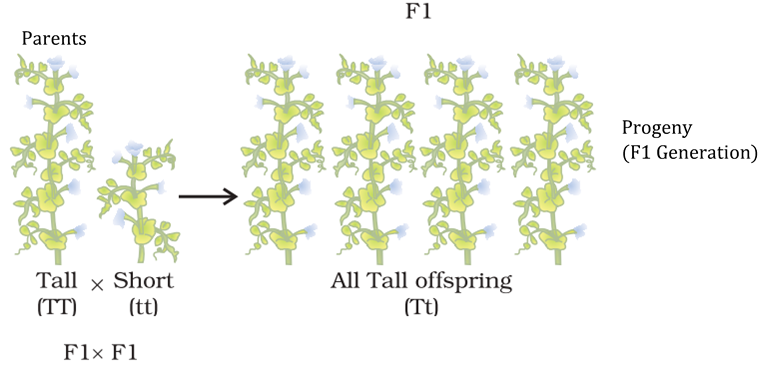
Then, Mendel self-pollinated the F1 plants and observed that all plants obtained in the F2 generation were not tall. Instead, one-fourth of the F2 plants were short.
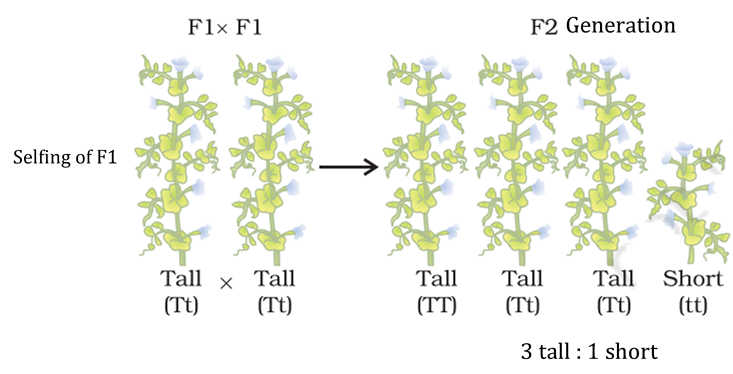
Self-pollination of F1 plants
From this experiment, Mendel concluded that the F1 tall plants were not true breeding. They were carrying traits of both short height and tall height. They appeared tall only because the tall trait is dominant over the dwarf trait.
Question 2: How do Mendel’s experiments show that traits are inherited independently?
Answer: Mendel crossed pea plants having round green seeds (RRyy) with pea plants having wrinkled yellow seeds (rrYY).
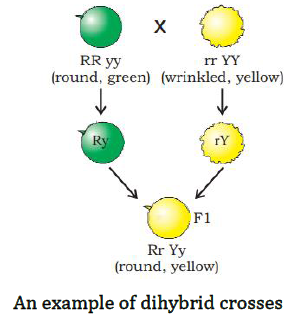
Since the F1 plants are formed after crossing pea plants having green round seeds and pea plants having yellow wrinkled seeds, F1 generation will have both these characters in them. However, as we know that yellow seed colour and round seeds are dominant characters, therefore, the F1 plants will have yellow round seeds.
Then this F1 progeny was self-pollinated and the F2 progeny was found to have yellow round seeds, green round seeds, yellow wrinkled seeds, and green wrinkled seeds in the ratio of 9:3:3:1.
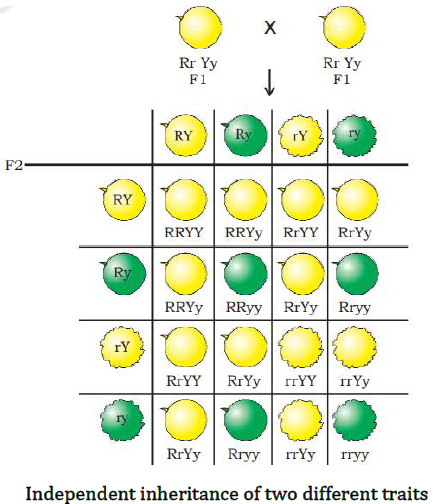
In the above cross, more than two factors are involved, and these are independently inherited.
Question 3: A man with blood group A marries a woman with blood group O and their daughter has blood group O. Is this information enough to tell you which of the traits − blood group A or O − is dominant? Why or why not?
Answer: Given information is not enough to tell us which characteristics are dominant –blood group A or O. Blood type A is always dominant in the type of ABO blood and blood type O is always recessive. Here, father’s group of blood may be genotypically AA (homozygous) or AO (heterozygous), where as that of mother can be OA or OO.
Question 4: How is the sex of the child determined in human beings?
Answer: In human beings, the females have two X chromosomes and the males have one X and one Y chromosome. Therefore, the females are XX and the males are XY.
The gametes, as we know, receive half of the chromosomes. The male gametes have 22 autosomes and either X or Y sex chromosome.
Type of male gametes: 22+X or 22+ Y.
However, since the females have XX sex chromosomes, their gametes can only have X sex chromosome.
Type of female gamete: 22+X

Thus, the mother provides only X chromosomes. The sex of the baby is determined by the type of male gamete (X or Y) that fuses with the X chromosome of the female.
Intext Question (Page No. 150)
Question 1: What are the different ways in which individuals with a particular trait may increase in a population?
Answer: An individual attribute could increase in a population within the following 2 ways:
(a) Natural selection: if an attribute is useful to a population, it’ll increase naturally.
As an example – inexperienced colorize beetles is favorable because it helps them in camouflage against the predators.
(b) Genetic drift: If a population faces an accident such majority of its members get killed, the remaining members can pass away their traits to the following generations. This may result in a rise of the attribute within the population.
Question 2: Why are traits acquired during the life-time of an individual not inherited?
Answer: This happens because an acquired trait involves change in non-reproductive tissues (somatic cells) which cannot be passed on to germ cells or the progeny. Therefore, these traits cannot be inherited.
Question 3: Why are the small numbers of surviving tigers a cause of worry from the point of view of genetics?
Answer: The small numbers of surviving tigers are a cause of worry from the point of view of genetics because in tigers there are negligible genetic variations. Due to this they are not well adapted. The rapid environmental changes cannot be favouable for them. If these changes are not controlled, tigers would be wiped out.
Intext Question (Page No. 151)
Question 1: What factors could lead to the rise of a new species?
Answer: Factors that would cause the increase of a brand new species are as follows:
(a) Natural activity.
(b) Method of genetic drift.
(c) Mutation.
(d) Geographical isolation.
(e) Environmental factors on the isolated populations.
(f) Generative isolation for a protracted time.
(g) Quantum of genetic variant transmissible from one generation to the following generation.
Question 2: Will geographical isolation be a major factor in the speciation of a self-pollinating plant species? Why or why not?
Answer: Geographical isolation can prevent the transfer of pollens among different plants. However, since the plants are self-pollinating, which means that the pollens are transferred from the anther of one flower to the stigma of the same flower or of another flower of the same plant, geographical isolation cannot prevent speciation in this case.
Question 3: Will geographical isolation be a major factor in the speciation of an organism that reproduces asexually? Why or why not?
Answer: Geographical isolation prevents gene flow between populations of a species whereas asexual reproduction generally involves only one individual. In an asexually reproducing organism, variations can occur only when the copying of DNA is not accurate. Therefore, geographical isolation cannot prevent the formation of new species in an asexually reproducing organism.
Intext Question (Page No. 156)
Question 1: Give an example of characteristics being used to determine how close two species are in evolutionary terms.
Answer: The presence of feathers in dinosaurs and birds indicates that they are evolutionarily related. Dinosaurs had feathers not for flying but instead these feathers provided insulation to these warm-blooded animals. However, the feathers in birds are used for flight. This proves that reptiles and birds are closely related and that the evolution of wings started in reptiles.
Question 2: Can the wing of a butterfly and the wing of a bat be considered homologous organs? Why or why not?
Answer: Homologous organs perform completely different functions and have different look however share common basic structural structure. The origin wings of a butterfly are composed of polysaccharide membrane, whereas wings of a bat are composed of bony skeleton. Hence, these aren’t homologous organs rather analogous organs.
Question 3: What are fossils? What do they tell us about the process of evolution?
Answer: Fossils: Fossils are the remains or traces of a dead organism. These are formed through the formation of sedimentary rocks. They provide following information on the process of evolution.
- They tell about the changes that occured on the earth’s surface and the corresponding organisms.
- They tell about the gradual development of complex structured organisms from simple structured organisms.
- It is known through them that birds are evolved from reptiles.
- They state that angiosperms are developed from pteriodophytes and gymnosperms.
- They exhibit the process of human evolution.
Intext Question (Page No. 158)
Question 1: Why are human beings who look so different from each other in terms of size, colour and looks said to belong to the same species?
Answer: A species is a group of organisms that are capable of interbreeding to produce a fertile offspring. Skin colour, looks, and size are all variety of features present in human beings. These features are generally environmentally controlled. Various human races are formed based on these features. However, there is no biological basis to this concept of races.
Therefore, all human beings are a single species as humans of different colour, size, and looks are capable of reproduction and can produce a fertile offspring.
Question 2: In evolutionary terms, can we say which among bacteria, spiders, fish and chimpanzees have a ‘better’ body design? Why or why not?
Answer: No, we can’t say there’s a better body design as these organisms evolved to survive in the environment according to their needs. If a chimpanzee has strong limbs capable of multiple actions, the bacteria can survive in extreme conditions where it is impossible for other organisms. Therefore there is no better design of the body.
NCERT Solutions for Class 10 Science Chapter 9 Exercise Questions
Question 1: A Mendelian experiment consisted of breeding tall pea plants bearing violet flowers with short pea plants bearing white flowers. The progeny all bore violet flowers, but almost half of them were short. This suggests that the genetic make-up of the tall parent can be depicted as
(a) TTWW
(b) TTww
(c) TtWW
(d) TtWw
Answer: (c) TtWW
Since all the progeny bore violet flowers, it means that the tall plant having violet flowers has WW genotype for violet flower colour. Since the progeny is both tall and short, the parent plant was not a pure tall plant. Its genotype must be Tt.
Therefore, the cross involved in the given question is

Therefore, half the progeny is tall, but all of them have violet flowers.
Question 2: An example of homologous organs is
(a) our arm and a dog’s fore-leg
(b) our teeth and an elephant’s tusks
(c) potato and runners of grass
(d) all of the above
Answer: (b) our teeth and an elephant’s tusks.
Question 3: In evolutionary terms, we have more in common with
(a) a Chinese school-boy
(b) a chimpanzee
(c) a spider
(d) a bacterium
Answer: (a) a Chinese school boy.
Question 4: A study found that children with light – coloured eyes are likely to have parents with light coloured eyes. On this basis, can we say anything about whether the light eye colour trait is dominant or recessive? Why or why not?
Answer: Let us assume that children with light – coloured eyes can either have LL or Ll or ll genotype. If the children have LL genotype, then their parents will also be of LL genotype.

If the children with light coloured eyes have ll genotype, then their parents will also have ll genotype.

Therefore, it cannot be concluded whether light eye colour is dominant or recessive.
Question 5: How are the areas of study − evolution and classification − interlinked?
Answer: Classification and evolution are extremely interlinked fields of study. Classification is influenced by evolution. The fashionable system of classification is additionally known as biological process classification; which implies it’s supported biological process relationships. Hence, evolution and classification are closely connected.
Question 6: Explain the terms analogous and homologous organs with examples.
Answer: Homologous organs: are similar in origin (or are embryologically similar) but perform different functions. For example, the forelimbs of humans and the wings of birds look different externally but their skeletal structure is similar. It means that their origin is similar (as wings in birds are modifications of forearm) but functions are different – the wings help in flight whereas human forearm helps in various activities.
Analogous organs: on the other hand, have different origin but perform similar functions. For example, the wings of a bird and a bat are similar in function but this similarity does not mean that these animals are more closely related. If we carefully look at these structures, then we will find that the wings of a bat are just the folds of skin that are stretched between its fingers whereas the wings of birds are present all along the arm. Therefore, these organs are analogous organs.
Question 7: Outline a project which aims to find the dominant coat colour in dogs.
Answer: Dogs have a variety of genes that govern coat colour. There are at least eleven identified gene series (A, B, C, D, E, F, G, M, P, S, T) that influence coat colour in dog.
A dog inherits one gene from each of its parents. The dominant gene gets expressed in the phenotype. For example, in the B series, a dog can be genetically black or brown. Let us assume that one parent is homozygous black (BB), while the other parent is homozygous brown (bb).
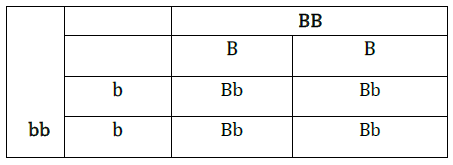
In this case, all the offsprings will be heterozygous (Bb).
Since black (B) is dominant, all the off-springs will be black. However, they will have both B and b alleles.
If such heterozygous pups are crossed, they will produce 25% homozygous black (BB), 50% heterozygous black (Bb), and 25% homozygous brown (bb) offsprings.
| 0 | B | b |
| B | BB | Bb |
| b | Bb | Bb |
Question 8: Explain the importance of fossils in deciding evolutionary relationships.
Answer: Fossil give evidence about
(a) The organisms that lived way back like the fundamental quantity throughout that they lived, their structure etc.
(b) Biological process development of species i.e., line of their development.
(c) Connecting links between 2 teams. As an example, feathers gift in some dinosaurs implies that birds are terribly closely associated with reptiles.
(d) That organisms evolved earlier and which later.
(e) Development of complicated body styles from the straightforward body designs.
Question 9: What evidence do we have for the origin of life from inanimate matter?
Answer: A British scientist, J.B.S. Haldane, suggested that life originated from simple inorganic molecules. He believed that when the earth was formed, it was a hot gaseous mass containing elements such as nitrogen, oxygen, carbon, hydrogen, etc. These elements combined to form molecules like water (H2O), carbon dioxide (CO2), methane (CH4), ammonia (NH3), etc.
After the formation of water, slowly the earth surface cooled and the inorganic molecules interacted with one another in water to form simple organic molecules such as sugars, fatty acids, amino acids, etc. The energy for these reactions was provided by solar radiations, lightning, volcanic eruptions, etc.
This was proved by the experiment of Stanley L. Miller and Harold C. Urey in 1953. They took a mixture of water (H2O), methane (CH4), ammonia (NH3), and hydrogen gas (H2) in a chamber and sparks were passed through this mixture using two electrodes. After one week, 15% of the carbon from methane was converted into amino acids, sugars, etc. These organic molecules are polymerized and assembled to form protein molecules that gave rise to life on earth.
Question 10: Explain how sexual reproduction gives rise to more viable variations than asexual reproduction. How does this affect the evolution of those organisms that reproduce sexually?
Answer: Sexual reproduction causes a lot of viable variations because of the subsequent reasons:
(a) Error in repetition of deoxy ribonucleic acid, that don’t seem to be extremely vital.
(b) Random segregation of paternal and maternal body at the time of sex cell formation.
(c) Exchange of genetic material between homologous chromosomes throughout formation of gametes.
(d) Accumulation of variations occurred because of reproduction over generation after generation and choice naturally created wide diversity.
(e) In case of agamogenesis, solely the terribly tiny changes because of inaccuracies in deoxy ribonucleic acid copying pass away the relative. Thus, off springs of agamogenesis are a lot of or less genetically just like their folks. So, it will be ended that evolution in sexually reproducing organisms proceed at a quicker pace than in asexually reproducing organisms.
Question 11: How is the equal genetic contribution of male and female parents ensured in the progeny?
Answer: In human beings, every somatic cell of the body contains 23 pairs of chromosomes. Out of these 23 pairs, the first 22 pairs are known as autosomes and the remaining one pair is known as sex chromosomes represented as X and Y.
Females have two X chromosomes and males have one X and one Y chromosome. The gamete receives half of the chromosomes. Therefore, the male gametes have 22 autosomes and either X or Y chromosome.
The female gamete, on the other hand, has 22 autosomes and X chromosome.
During reproduction, the male and female gametes fuse and thus the progeny receives 22 autosomes and one X or Y chromosome from male parent and 22 autosomes and one X chromosome from the female parent.
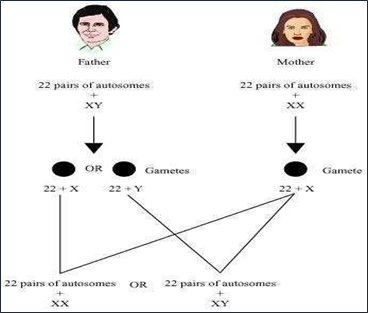
Question 12: Only variations that confer an advantage to an individual organism will survive in a population. Do you agree with this statement? Why or why not?
Answer: We agree with the statement that solely variations that confer a plus to a private organism can survive during a population. All the variations don’t have associate equal likelihood of extant within the setting within which they notice themselves. The possibilities of extant rely upon the character of variations. Totally different individual would have different reasonably benefits. Bacterium which will face up to heat will survive higher during a wave. Choice of variants by environmental factors forms the idea for revolutionary method.
Topics covered under Class 10 Science Chapter 9 Heredity and Evolution
Below we have listed the topics discussed in NCERT Solutions for Class 10 Science Chapter 9. The list gives you a quick look at the different topics and subtopics of this chapter.
| Section in NCERT Book | Topics Discussed |
|---|---|
| 9.1 | Accumulation of Variation During Reproduction |
| 9.2 | Heredity |
| 9.3 | Evolution |
| 9.4 | Speciation |
| 9.5 | Evolution and Classification |
| 9.6 | Evolution Should not be Equated with Progress |
| 9.6.1 | Human Evolution |
NCERT Solutions for Class 10 Science Chapter 9 – A Brief Discussion
Chapter Overview: Have you ever wondered why you resemble some characteristics of your mother and father? The answer is pretty simple. It actually due to the inheritance of traits/characters that the offspring inherit from their parents. Inheritance of traits from parents is also called as heredity. In this chapter, you will learn how heredity brings variation in genes and helps in evolution. This chapter covers some important topics like how inherited traits get expressed in offsprings, speciation, evolution and classification. Heredity and Evolution is an interesting chapter. We advise you read the chapter in NCERT book for better understanding.